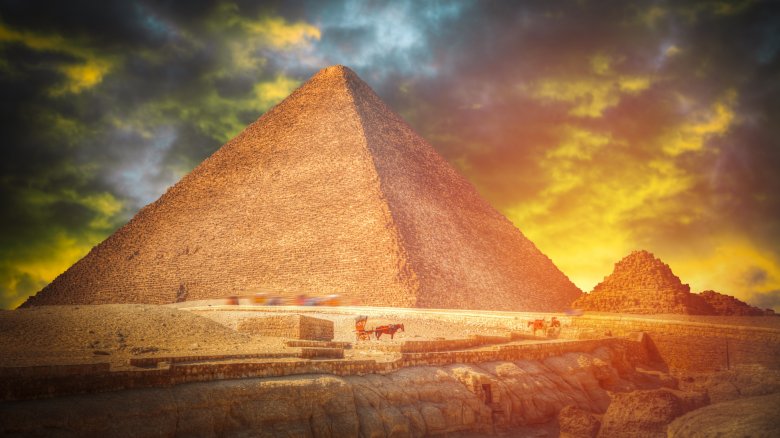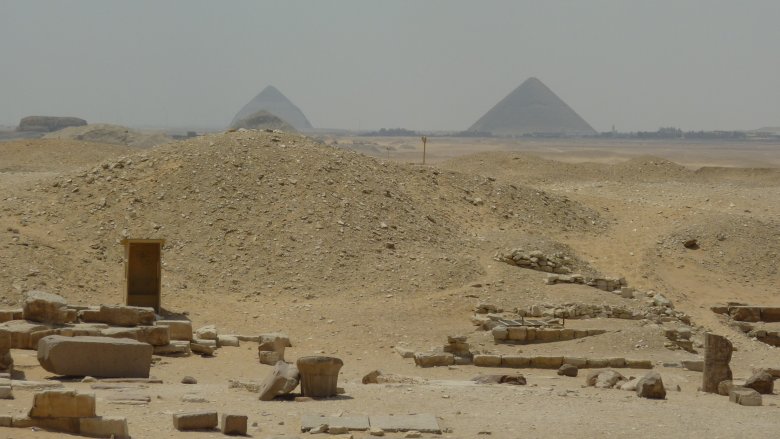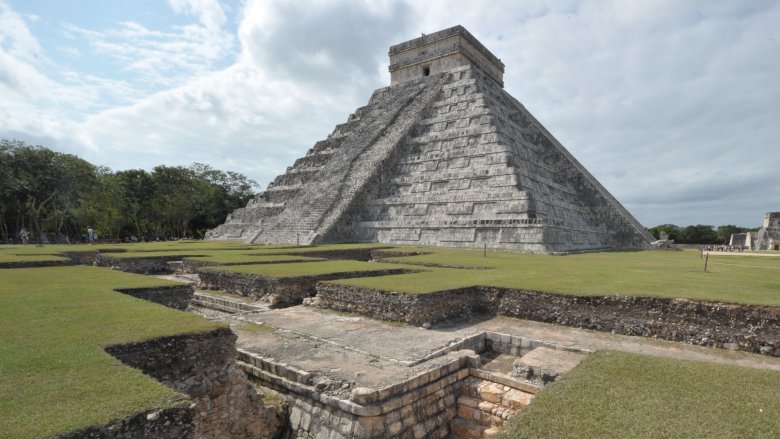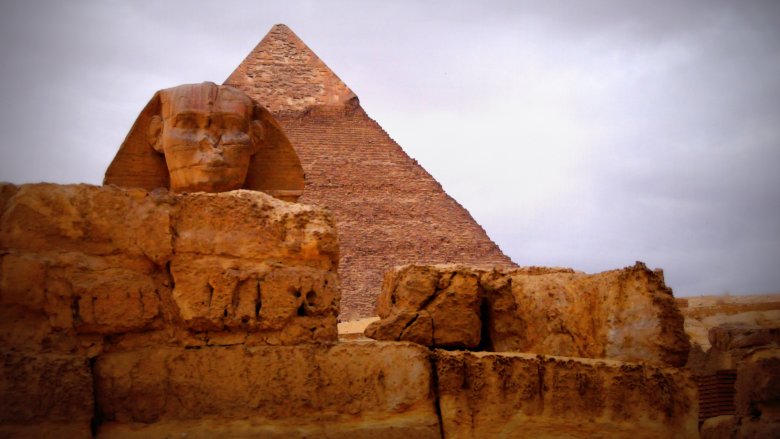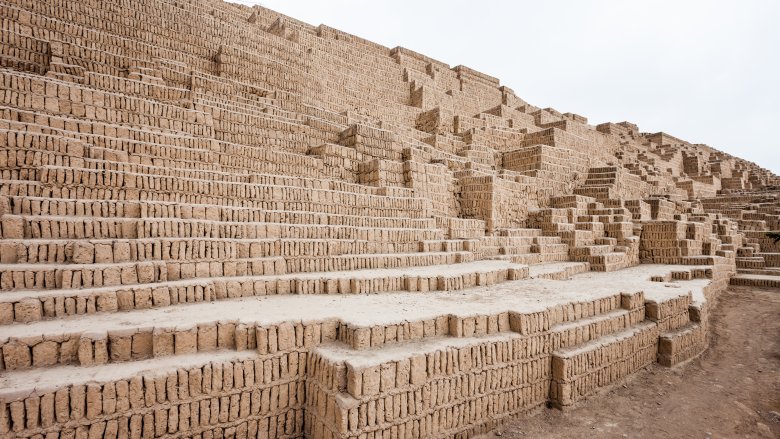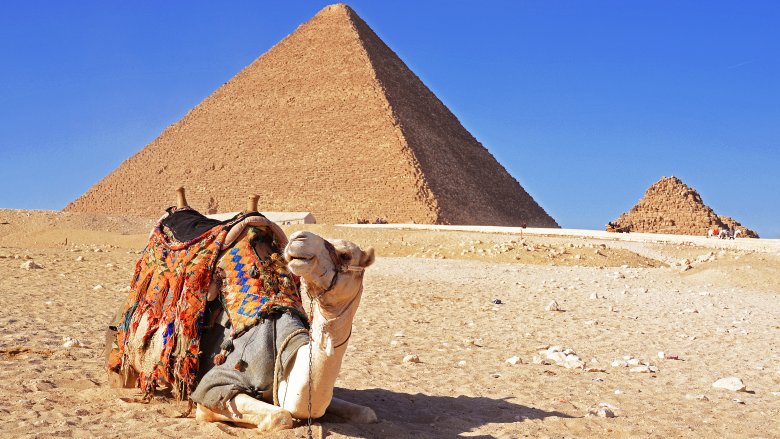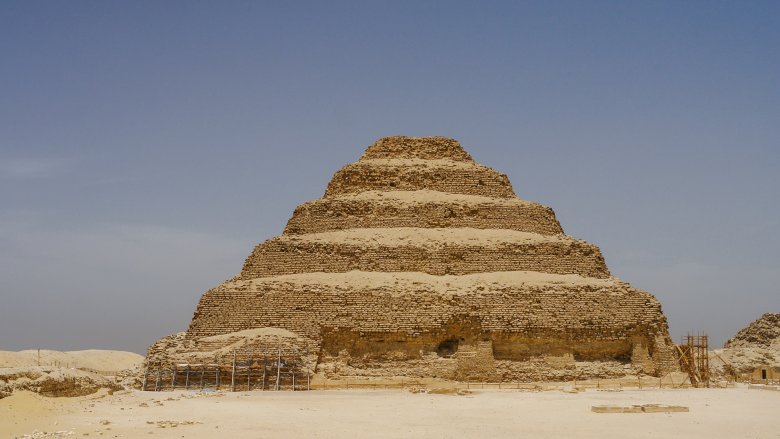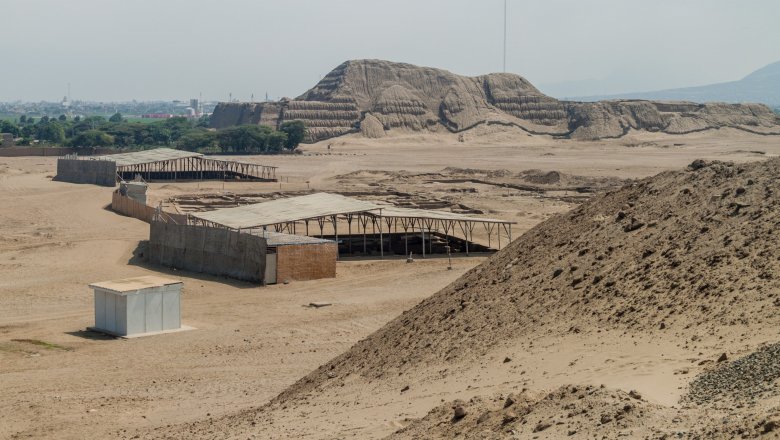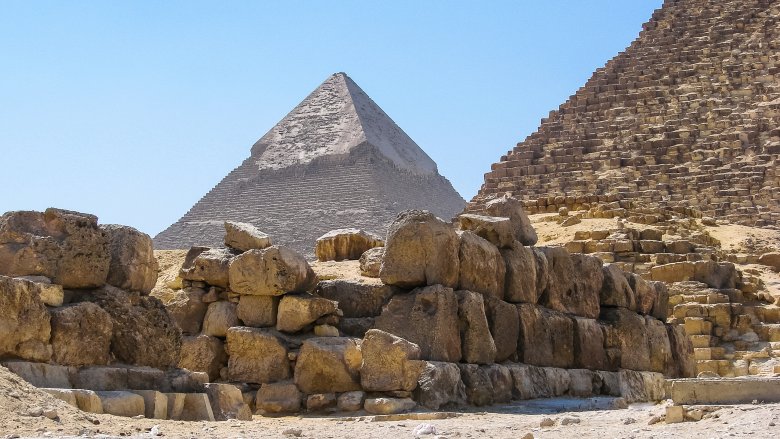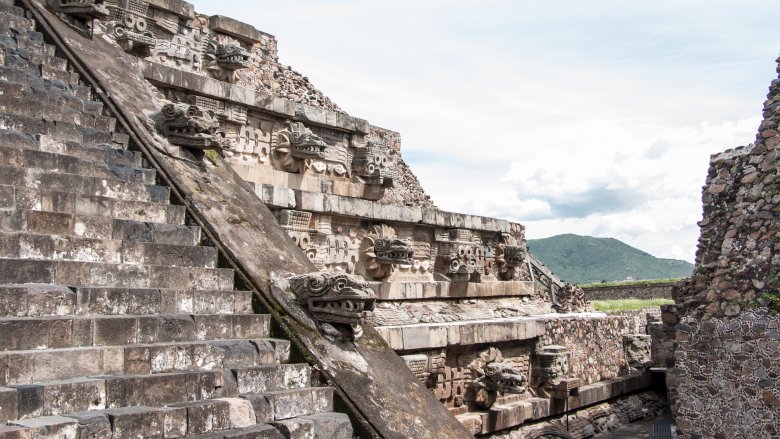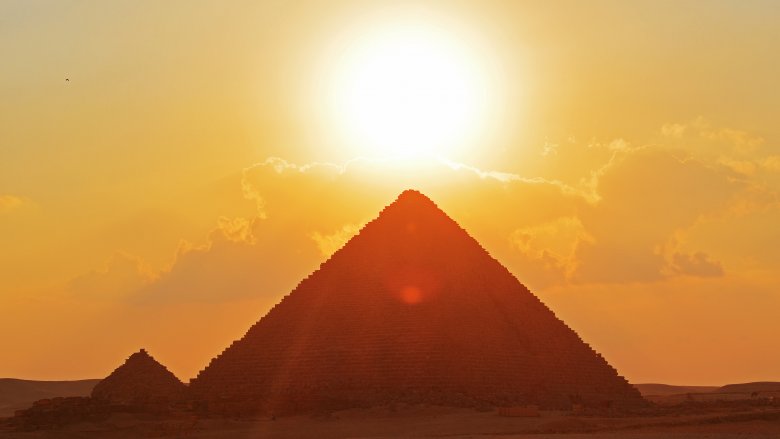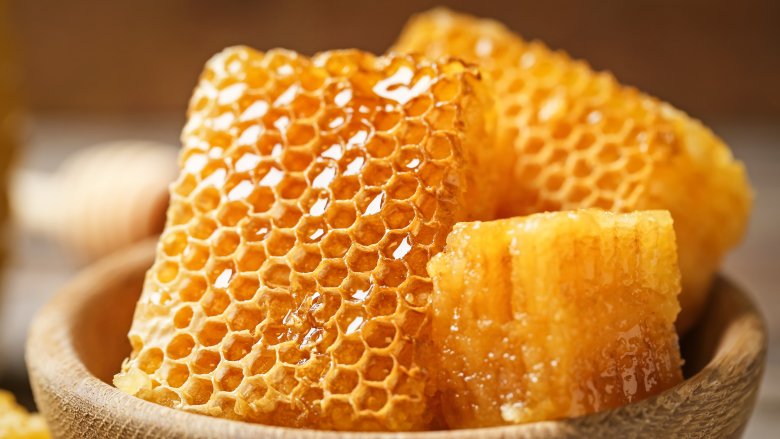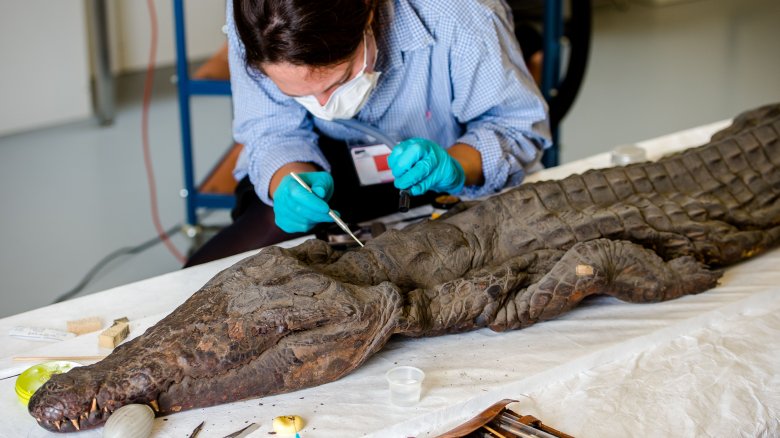Bizarre Things Discovered Inside Pyramids
As a whole, the human race thinks it's pretty darn cool, partially because we build all kinds of incredible things, from tall buildings to super, high-tech ones. But in all fairness, we also have a huge amount of help when it comes to doing the actual heavy lifting. Machines do all that for us now, but the pyramids scattered across the world are a reminder of those who came before us and who didn't have the help we take for granted today. Those pyramids — and the secrets we're still unlocking — are also a reminder that we're not nearly as cool as our ancestors were. We're all equally weird, though.
The two pyramids of Ameny Qemau
The one thing the human race has been consistently good at throughout our planetary existence is ruining things, so there's only part of this particular, 3,800-year-old pyramid left in Dahshur, Egypt. In 2017, researchers announced they had identified the pharaoh of this pyramid (via LiveScience). The name "Ameny Qemau" had been inscribed on an alabaster block, so no mystery here, right?
Not so fast. Archaeologists had already found Ameny Qemau's pyramid in 1957, also in Dahshur, sitting about 2,000 feet away from this one (via LiveScience). It gets even weirder when you consider he wasn't even that important of a pharaoh — he only ruled for around two years, sometime in the vicinity of 1790 B.C. Why does he have two pyramids? What makes him so special?
About a month after the original discovery was announced, archaeologists said they might have a possible reason. They found a burial chamber, and it didn't contain the pharaoh. Instead, they found a wooden box with the name "Hatshepset" carved onto it, and they worked backward from there. The boxes were used to hold canopic jars, which would in turn hold organs. Now, the theory is that Hatshepset (not the other, more famous Hatshepsut) was Ameny Qemau's daughter, and when she died, her father essentially took someone else's pyramid, scratched out their name, wrote in his, and used it to bury his daughter. That's ... sweet?
More pyramids
You've seen the Kukulkan pyramid at Chichen Itza, even if you don't know the name of it. It's the most famous Mayan ruin, but we barely know anything about it. It was only in 2016 that researchers announced they had discovered something bizarre inside: another pyramid. Even weirder, this was the second pyramid found inside the iconic outer shell.
According to CNN, excavations in 1930 revealed Kukulkan (or El Castillo) was built over another pyramid. That pyramid was found to contain a red jaguar throne decorated with jade, but it was almost another century before we figured out that pyramid had itself been built over a pre-existing pyramid. We haven't gotten a good look at the newly discovered third one, but based on thermal imaging we're pretty sure it was outfitted with at least a small staircase and an altar of some kind.
Archaeologists have some rough guesses at when these nesting-doll style pyramids were built, and say the outer shell we're all familiar with only dates back to the end of the Maya-Tolteca period, about 1,000 years ago. The second shell dates back to between the years 800 to 1000, and the innermost pyramid is old enough that it's likely in the "pure Maya" style. Given that we don't actually know too much about the Maya, that'd be pretty darn cool.
A tiny sarcophagus
The debate about when a life becomes a life has been raging for a long time, and it's probably not going to be settled anytime soon. We're not here to talk about that, but we are here to talk about ancient Egyptian beliefs on the matter. Archaeologists are pretty sure they know exactly what those beliefs were because of a tiny sarcophagus originally removed from Giza in a 1907 excavation, according to The Telegraph.
The little sarcophagus was intricately carved but in a severe state of decay, so archaeologists from the Fitzwilliam Museum only recently used imaging technology to peek inside. They assumed they were going to find embalmed organs from an adult, but instead, they found the carefully arranged remains of a miscarried child, somewhere between 16 and 18 weeks old. The little arms were crossed, and they say the coffin is a perfect miniature of other wooden coffins used between 664 and 525 B.C.
Julie Dawson of the Fitzwilliam Museum issued this statement: "This ground-breaking find educated us further still in our conception of just how precious the unborn child was in ancient Egyptian society. The care taken in the preparation of this burial clearly demonstrates the value placed on life even in the first weeks of its inception."
Chinese skeletons in a Peruvian pyramid
You expect to find ancient things in a pyramid, and while the 20th century is now officially "old," it's by no means ancient. In 2017, the Peruvian Ministry of Culture announced a strange find (via Reuters): the remains of 16 Chinese laborers, buried on the top of a pre-Colombian adobe pyramid called a huaca. The pyramids were built by an ancient people called the Ichma, who thrived around 1,000 years ago until their assimilation by the Inca and ultimate destruction at the hands of the Spanish conquistadors.
The story of how the Chinese remains got there was pieced together from a bit of history you probably didn't cover in school. According to researchers from Brown University (via The Smithsonian), around 100,000 Chinese immigrants were lured to Peru under false pretenses (or just outright kidnapped) toward the end of the 19th century and the beginning of the 20th. It started after Peru outlawed slavery and plantations needed another way to get the cheap labor they needed. Immigrants were forced to work in place of slaves, but conditions weren't much better.
Which brings us to the question of how these 16 ended up buried atop an ancient pyramid. The Chinese community was — for the most part — not allowed to bury their dead in Peru's Catholic cemeteries. They had to look elsewhere, and this particular group looked to the past.
A 100-foot-long chamber
In 2017, National Geographic reported on what Egyptologist Yukinori Kawae called "the discovery of the century." That's quite a claim, Kawae! The Great Pyramid of Giza is the pyramid everyone thinks of when they think "pyramid," and the ScanPyramid project has been using some super high-tech gadgets and gizmos (that's the scientific term) to look inside Khufu's massive pyramid for some time now. They've seen thermal signatures that indicate voids, but that's largely been written off as a byproduct of the building process instead of being any planned interior structure. Now, they've confirmed there's a massive void at least 100 feet long positioned directly over the long hallway leading to Khufu's burial chamber, and it looks like it was intentional.
So, what is it? No one really knows, but there are a few guesses. One Cambridge archaeologist suggests the void's alignment with the massive stone blocks forming the top of the King's Chamber makes it likely the void was just left behind by the stage of construction that moved those huge blocks into place, but others disagree. Forbes says other researchers (i.e., party poopers) were quick to point out there's probably not a connection to anything super mysterious or occult-ish, which pretty much ruins our idea of archaeology. Since the void is completely sealed and there are no access points, it's unlikely we'll be finding out for sure what's inside anytime soon.
No burial chambers
Pyramids are incredibly impressive burial places for incredibly impressive people, and Science Alert says there are a few ways we know this, despite what certain "politicians" and nutty conspiracy theorists might think. One giveaway is the presence of burial chambers and, well, burials. It's a pretty good giveaway at that, but it makes the complete lack of any burial chambers in the pyramids of southern Egypt a little problematic.
According to LiveScience, a 2014 excavation found the 4,600-year-old step pyramid of Edfu had no burial chamber whatsoever. The Edfu pyramid is actually one of a set of seven pyramids scattered across southern Egypt. Six — including Edfu — are weirdly identical, and before you go all conspiracy theory on us, archaeologists think it's simply proof there was a widespread, sprawling construction plan. Since they weren't used for burials, they clearly had some other purpose that made it worth the hassle of building, and excavations found a few other clues, like food offerings and child burials.
It's now believed these smaller provincial pyramids were essentially monuments built to remind people they lived under the watchful eye of the pharaoh. The food offerings were left to him but the child burials came later, as the building of Khufu's Great Pyramid seemed to render these obsolete. That happened only about 50 years after they were completed, which must have peeved the heck out of the builders.
The Lady of Cao
Sure, you expect to find a mummy inside a pyramid. But the mummy uncovered in Peru and dubbed the "Lady of Cao" was something completely unexpected, for a few different reasons. When National Geographic announced the discovery in 2006, they noted that the woman who was laid to rest in a mud-brick pyramid along Peru's northern coast was buried with an extraordinary amount of grave goods. She was a part of the Moche culture, and while we don't know that much about them, no one expected to find a female mummy buried with a huge amount of military gear, included massive war clubs and spear throwers.
Archaeology took a more in-depth look at the lady herself, and says she was covered with tattoos. The markings on her mummified skin are one of the few examples we have of Moche tattooing practices, and she was found to have stylized depictions of cats, snakes, crabs, catfish, and spiders inked onto her skin, along with a supernatural creature archaeologists simply call the Moon Animal. They're not sure what the tattoos represented, but they do say she was obviously of high standing, had the respect of her people, and was likely nobility or religious elite. We're just hoping she's eventually allowed to just rest in peace.
Some ancient graffiti
There's plenty we don't know about our ancient ancestors, and it's easy to turn them into distant, enigmatic figures. But deep down, they were people just like us.
According to Nova, Egyptologists have found traces left behind by the builders of the pyramid at Giza in the form of ancient graffiti. It's a very human thing to want to leave your name somewhere prominent, to make your little mark on the world. This ancient writing was left in red paint and included the names that pyramid work crews gave themselves. Names like "The Friends of Khufu Gang" and "The Drunkards of Menkaure" were scrawled on some of the giant stone blocks, which doesn't really mesh with the idea that slaves were forced to labor away on the pyramids.
Other graffiti has been found etched into the pyramids, too, and most of it dates from Imperial Rome. According to Slate, the Romans viewed the pyramids as a sort of guestbook they needed to sign while on holiday. Our favorite piece of wisdom came from a Roman tourist scrawling a bit of ancient pop culture onto one of the Great Wonders of the World. He or she etched, "I looked, I investigated, I arrived, I marveled."
A secret tunnel and liquid mercury
It started in 2003, when archaeologists found a secret tunnel under Teotihuacan's Feathered Serpent Pyramid. Over the next 14 years, they made their way further and further inside the pyramid, and for the first time in 1,800 years humans laid eyes on an underground landscape in miniature. There were little mountains, tiny lakes made of liquid mercury, and sparkling walls and ceilings. The tunnel was covered with fool's gold, and when the light hit it, it twinkled like fire and starlight.
It sounds like we're making this up, but we're not. In 2017, The Guardian reported on the opening of a public exhibition based on the incredible discoveries made in and under the pyramid that's also been called the Pyramid of the Moon. Honestly, if the Doctor ever stops by and asks if you'd like to hitch a ride on the TARDIS, this is the place to go. Archaeologists say the whole thing was even more impressive in its heyday.
Watermarks in the underground passage seem to prove the entire complex was occasionally flooded in a religious ceremony acting out a creation myth, and it's believed the gold-lined chamber was meant to be the underworld. Terrifying, sure, but if that's what the afterlife was supposed to look like, you can see why people might volunteer to be sent there a little faster than normal.
An early security system
Anyone who went through that phase of wanting to be an archaeologist because of Indiana Jones was probably reminded — on countless occasions — that it's not really like that at all. But sometimes, it totally is.
When Khufu's Great Pyramid was built, the architects knew it was going to be a target for tomb raiders. So, they built what Egyptologist Mark Lehner calls (via LiveScience) "a very primitive machine" to act as a sort of security system. After Khufu's remains were placed in his burial chamber, the chamber could be secured with the release of three giants slabs of rock that would slide down carved grooves and block the entrance to the chamber. Then, they could release three more giant stone blocks that would block the entrance to the tunnel, preventing access to the inner sanctum and Khufu himself.
Did it work? Actually, no one knows. When the King's Chamber was excavated, archaeologists found a red granite sarcophagus. It was empty, though, so maybe the security system didn't work. Some think the sarcophagus was just another part of the security system: a decoy. If Khufu's remains are still in the pyramid, they must be quite well secured. All right, Indy. Archaeology is awesome.
Food fit for a pharaoh... way past the expiration date
Pyramids were about more than just laying someone to rest because according to Egyptian beliefs, they also needed to have everything the person might need to spend eternity in comfort. That was a tall order, and no one wants to spend eternity feeling a little peckish. Take King Tut's tomb. He was buried with all kinds of munchies, and fortunately, National Geographic says enough of the containers and contents have survived that they were able to identify just what was on his eternal menu.
There were baskets of things like wheat, barley, melons, figs, dates, and grapes, along with jars and jars of wine. Each jar was carefully labeled with the vineyard, the year, and the vintner immortalized on the jar — presumably so Tut would know who to toast. There were also boxes of preserved beef, duck, goose, and other small birds, but no fish. Why? They weren't just preparing a meal, they were preparing for an eternity of meals — so they only used the very best. Fish was just so common.
Tut also had an 8-inch-tall jar that was filled with honey, which was well-known as a sweet treat, a gift worthy of the gods, and part of the embalming process. National Geographic also says some of the 3,000-year-old honey recovered from Egyptian tombs is still perfectly edible ... although there's no word on whether anyone has tried it.
More than just cats
The Egyptians' infatuation with cats is legendary: The old joke goes that cats have never forgotten their sacred status. (But hopefully they've forgotten they used to be born, bred, and strangled by priests solely for mummification — probably, says National Geographic.) But other animals have been found, too.
National Geographic reports archaeologists have recovered mummified rams and gazelles, shrews, ibises, dogs, entire bulls, and even scarab beetles with their own little dung balls. Kings and queens were often buried with their most cherished pets, which were likely killed for this purpose if their owner died. Now that science has made some major advances with scanning technology, the BBC says they've been able to peek inside some of the mummies. Crocodiles in particular have been found wrapped with tiny crocodile babies, which would be adorable if it weren't so dark.
Egyptian pyramids aren't the only ones that have yielded animal remains. According to IFL Science, big carnivores like wolves and pumas have been uncovered in the Moon and Sun pyramids in Mexico. Many of the bones bore signs of abuse, and when scientists examined those bones to see what they were being fed, they concluded the animals were probably being fed dogs and people. So there's another time and place future time travelers should just skip.
